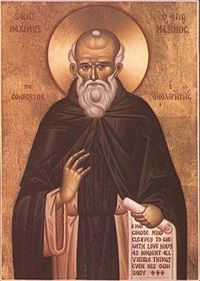Calendar of saints
The Calendar of saints is a traditional Christian method of organizing a liturgical year by associating each day with one or more saints and referring to the day as that saint's feast day. The system arose from the very early Christian custom of annual commemoration of martyrs on the dates of their deaths, or birth into heaven, and is thus referred to in Latin as dies natalis ("day of birth").
Contents |
History
As the number of recognized saints increased during Late Antiquity and the first half of the Middle Ages, eventually every day of the year had at least one saint who was commemorated on that date. To deal with this increase, some saints were moved to alternate days in some traditions or completely removed, with the result that some saints with more than one day feast day . The General Roman Calendar, in its various forms, contains only a selection of the saints for each of its days.
The earliest feast days of saints were those of martyrs, venerated as having shown for Christ the greatest form of love, in accordance with the teaching: "Greater love has no one than this, that someone lay down his life for his friends."[1] Saint Martin of Tours is said to be the first[2][3] or at least one of the first non-martyrs to be venerated as a saint. The title "confessor" was used for such saints, who had confessed their faith in Christ by their lives rather than by their deaths. Martyrs are regarded as dying in the service of the Lord, and confessors are people who died natural deaths. A broader range of titles was used later, such as: Virgin, Pastor, Bishop, Monk, Priest, Founder, Abbot, Apostle, Doctor of the Church.
The Tridentine Missal has common formulas for Masses of Martyrs, Confessors who were bishops, Doctors of the Church, Confessors who were not Bishops, Abbots, Virgins, Non-Virgins, Dedication of Churches, and Feast Days of the Blessed Virgin Mary. Pope Pius XII added a common formula for Popes. The 1962 Roman Missal of Pope John XXIII omitted the common of Apostles, assigning a proper Mass to every feast day of an Apostle. The present Roman Missal has common formulas for the Dedication of Churches, the Blessed Virgin Mary, Martyrs (with special formulas for missionary martyrs and virgin martyrs), Pastors (subdivided into bishops, generic pastors, founders of churches, and missionaries), Doctors of the Church, Virgins, and (generic) Saints (with special formulas for abbots, monks, nuns, religious, those noted for works of mercy, educators, and [generically] women saints).
This calendar system, when combined with major church festivals and movable and immovable feasts, constructs a very human and personalised yet often localized way of organizing the year and identifying dates. Some Christians continue the tradition of dating by saints' days: their works may appear "dated" as "The Feast of Saint Martin". Poets such as John Keats commemorate the importance of The Eve of Saint Agnes.
Ranking of feast days
Feast days are ranked in accordance with their importance.
In what is now the ordinary form of the Roman Rite feast days are ranked (in descending order of importance) as solemnities, feasts or memorials (obligatory or optional).[4] The extraordinary form of the Roman Rite whose use is authorized by the motu proprio Summorum Pontificum divides liturgical days into I, II, III, and IV class days, as decreed by Pope John XXIII in 1960. Before 1960, feast days were ranked as Doubles (of three or four kinds), Semidoubles, and Simples. See Ranking of liturgical days in the Roman Rite.
In the Eastern Orthodox Church the ranking of feasts varies from church to church. In the Russian Orthodox Church they are: Great Feasts, All-Night Vigils, Polyeleos, Great Doxology, Sextupple (having six stichera at Vespers and six troparia at the Canon of Matins), Double (i.e., two simple feasts celebrated together) and Simple.
In the Church of England, there are Principal Feasts and Principal Holy Days, Festivals, Lesser Festivals, and Commemorations.
See also
- Coptic Orthodox calendar of saints
- Roman Catholic calendar of saints
- Calendar of saints (Episcopal Church in the United States of America)
- List of saints
- Movable feasts
- Name days
External links
- Calendar of Saints (Orthodox Church in America)
- Roman Catholic Saints' Calendar (American Catholic)
- Saint of the days (Greek Orthodox Archdiocese of Australia)
References
|
|||||||||||||||||||

